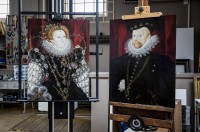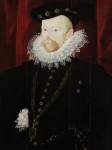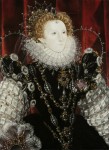 Two large-scale portraits in the Rothschild collection at Waddesdon Manor have been attributed to Nicholas Hilliard (1547–1619), the premiere miniature portraitist of the Tudor court. The portraits, one of Queen Elizabeth I and the other of her ambassador to France Sir Amias Paulet, were painted from life in oil on wood panels. There are references in archival documents to Hilliard having painted full-size portraits, “in greate,” they were called, and several portraits of Queen Elizabeth have been proposed as possible Hilliard works. Those attributions are based solely on stylistic comparisons with Hilliard’s miniatures, however, and it’s a tricky thing to compare features painted in watercolor-on-vellum miniatures to ones on large-scale oil paintings.
Two large-scale portraits in the Rothschild collection at Waddesdon Manor have been attributed to Nicholas Hilliard (1547–1619), the premiere miniature portraitist of the Tudor court. The portraits, one of Queen Elizabeth I and the other of her ambassador to France Sir Amias Paulet, were painted from life in oil on wood panels. There are references in archival documents to Hilliard having painted full-size portraits, “in greate,” they were called, and several portraits of Queen Elizabeth have been proposed as possible Hilliard works. Those attributions are based solely on stylistic comparisons with Hilliard’s miniatures, however, and it’s a tricky thing to compare features painted in watercolor-on-vellum miniatures to ones on large-scale oil paintings.
 The Rothschild portraits also share features characteristic of Hilliard’s conclusively attributed miniatures, particularly the treatment of the hair, lace, faces and jewels (Hilliard trained as a goldsmith and had an exceptionally keen eye for depicting jewelry in the most minute detail), but they have something the other candidates don’t have: hard evidence tying them to a specific period, location and context that dramatically increases the likelihood that they were painted by Nicholas Hilliard.
The Rothschild portraits also share features characteristic of Hilliard’s conclusively attributed miniatures, particularly the treatment of the hair, lace, faces and jewels (Hilliard trained as a goldsmith and had an exceptionally keen eye for depicting jewelry in the most minute detail), but they have something the other candidates don’t have: hard evidence tying them to a specific period, location and context that dramatically increases the likelihood that they were painted by Nicholas Hilliard.
It was conservators at the Fitzwilliam Museum’s Hamilton Kerr Institute who made the discovery while restoring the portraits.
Removal of old, discoloured varnishes revealed the brilliant red of the original background and allows the original painting technique to be fully appreciated. More exciting still was that scientific analysis carried by the Hamilton Kerr Institute showed that the paintings were made on panels constructed of French Oak rather than the Baltic oak typically used by English painters of the period.
 Paulet was Elizabeth’s ambassador to France from 1576 until 1579. During that period the Queen was considering marrying François, Duke of Anjou, the son of Henry II of France and Catherine de’ Medici. When his older brother ascended the throne as Henry III in 1574, François became the next in line to the French throne. He was made Duke of Anjou an Alençon in 1576 and boldly sought the hand of Queen Elizabeth in marriage. She was in her mid-40s and decidedly Protestant; he was in his early 20s and Catholic, and not just any Catholic, but the son of the “Jezebel” who was believed to have orchestrated the slaughter of Huguenots in the St. Bartholomew’s Day massacre.
Paulet was Elizabeth’s ambassador to France from 1576 until 1579. During that period the Queen was considering marrying François, Duke of Anjou, the son of Henry II of France and Catherine de’ Medici. When his older brother ascended the throne as Henry III in 1574, François became the next in line to the French throne. He was made Duke of Anjou an Alençon in 1576 and boldly sought the hand of Queen Elizabeth in marriage. She was in her mid-40s and decidedly Protestant; he was in his early 20s and Catholic, and not just any Catholic, but the son of the “Jezebel” who was believed to have orchestrated the slaughter of Huguenots in the St. Bartholomew’s Day massacre.
In the end, Anjou went the same way as all the rest of Elizabeth’s suitors, but for a while during years when Paulet was ambassador Anjou’s suit looked like it had a real chance. Paulet played an important diplomatic role in the negotiations. From 1576 to 1578, almost his entire ambassadorship, Hilliard was in France with Paulet, often following him as part of his retinue. He traveled the country with Paulet, painting royalty and courtiers. Hilliard even painted a miniature of Anjou himself in 1577.
 Both portraits have French elements in the depictions. Sir Amias Paulet wears the medallion of the Order of Saint Michel, a French order of chivalry symbolized by the Archangel Michael drawing his sword. The pelican jewel on Elizabeth’s chest features a fleur-de-lys. To top it off, not only are the portraits both painted on French oak panels; the panels of both paintings were cut from the same tree. Perhaps Paulet commissioned Hilliard to make the portraits to hang in the ambassador’s residence in Paris? It would explain why an ambassador would be the counterpart of his Queen in a pair of portraits.
Both portraits have French elements in the depictions. Sir Amias Paulet wears the medallion of the Order of Saint Michel, a French order of chivalry symbolized by the Archangel Michael drawing his sword. The pelican jewel on Elizabeth’s chest features a fleur-de-lys. To top it off, not only are the portraits both painted on French oak panels; the panels of both paintings were cut from the same tree. Perhaps Paulet commissioned Hilliard to make the portraits to hang in the ambassador’s residence in Paris? It would explain why an ambassador would be the counterpart of his Queen in a pair of portraits.
Attribution is always a challenge, and experts can and do engage in heated debate over these questions, but this is pretty much as good as it gets. As the Waddesdon Manor curator puts it:
The stylistic affinities with other works by the artist, together with the evidence that links these paintings with Hilliard’s time in France, allows scholars to attribute these splendid paintings to Hilliard with unprecedented confidence.
The newly attributed portraits will be on public display for the first time at Waddesdon Manor from June 7th through October 29th in a new exhibition, Power and Portraiture: painting at the court of Elizabeth I, which explores how Elizabeth and the members of her court used portraits to carefully curate their public presentation and self-image.
[youtube=https://youtu.be/TkkL0cFBtK0&w=430]